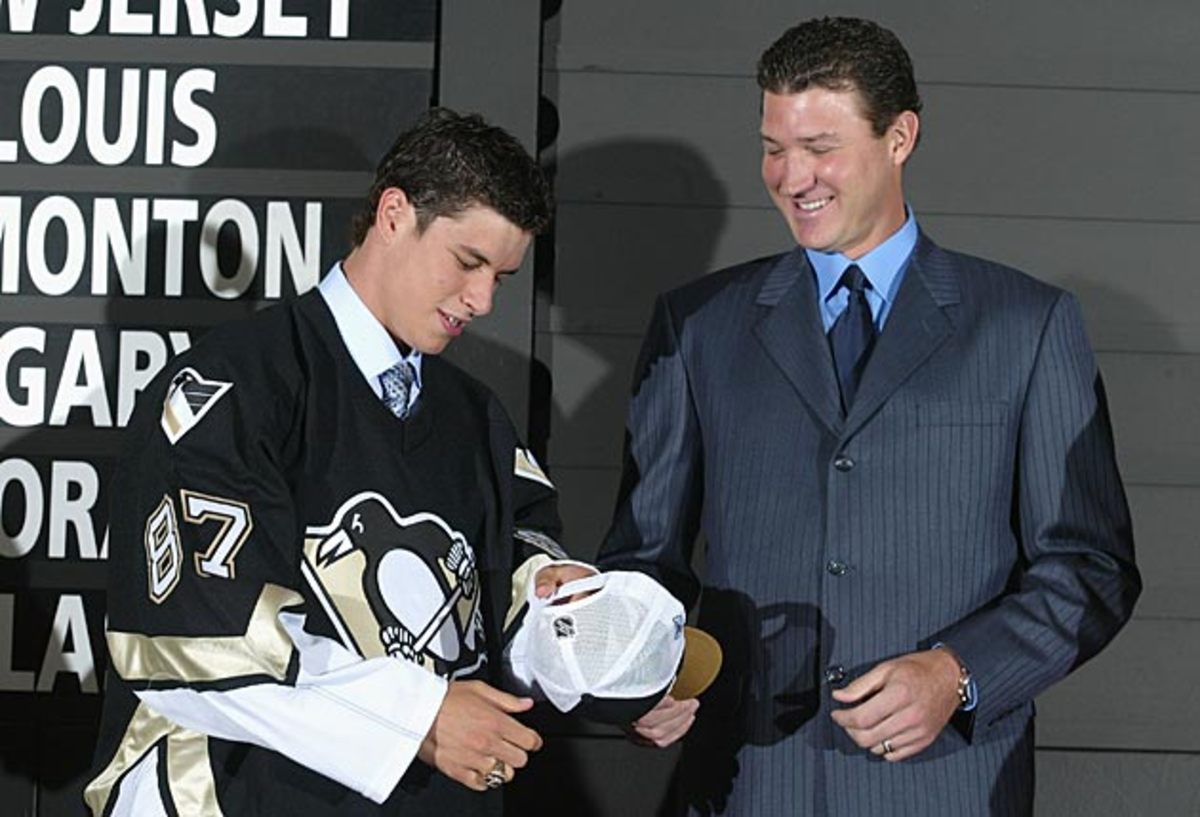An oral history of the 2005 NHL Draft

When the news came down on Wednesday, July 13, few hockey fans could barely believe it.
The lockout that canceled the 2004-05 NHL season and saw the Stanley Cup not awarded for the first time since 1919—when a flu epidemic, to put things in perspective—was over. Team owners and the NHLPA had reached a deal in principle and while it would take another nine days for both parties to officially ratify the agreement, there would be an NHL season starting that October.
And to many in the hockey world, that meant one thing: the debut of Sidney Crosby. The much-lauded prospect who had been avidly followed since he was a young teen phenom and earned his spot on the 2005 Canadian World Junior Team (arguably the best WJC team ever assembled) would begin his professional career.
SI Vault: Sidney Crosby's next stop is greatness
There was more than just Sid the Kid to get excited about, however. Experts were fawning over the deep draft class and to date, the first round alone has produced six players who have either played in the NHL All-Star Game or been named to league's First or Second All-Star team. Eight Olympians are in those ranks as well.
Yet drafts are usually held in late June, after the playoffs and lottery have determined the picking order. Things had to come together quite quickly, and the league was under enormous pressure to deliver a memorable event.
To celebrate the 10-year anniversary of one of the most significant NHL Entry Drafts, let’s take a look back with some of the biggest names who were involved with that milestone in Ottawa on June 25, 2005.
No time to waste
As soon as the owners and NHLPA had a deal in principle, the league got rolling on a formula for the 2005 NHL Entry Draft. A number of changes occurred, including a lottery system that awarded teams between one and three balls to be drawn. The Buffalo Sabres, Columbus Blue Jackets, New York Rangers and Pittsburgh Penguins were each given three, and the best odds of landing Crosby (6.3%), due to their having missed the playoffs in 2002, ’03 and ’04 seasons and not receiving the first pick in each of the ’01, ’02, ’03 and ’04 drafts,
Brian Burke, then GM of the Anaheim Ducks: “It was a whirlwind. It was a very compressed time frame.”
Gary Meagher, NHL Executive Vice President, Communications: “(The lottery) was never going to be based on the ’03-04 season. If we had some portion of the season obviously we would have had some structure in place. You might have had to change some of the rules slightly but that was all hypothetical because we never did end up getting there. When that happened it was a matter of really looking at what the options were. Understandably with 30 teams there were a lot of differing views amongst the hockey people in terms of what was the most fair way for the lottery to end up being. I recall we had a two-day meeting in Detroit at an airport hotel where this topic was on the agenda and there was a lot of discussion. Obviously it evoked a lot of emotion and passion because of what was at stake.”
Burke: “I think the teams that missed the playoffs the year before were clearly not happy. This notion that we had to start from scratch, with some weighting, but basically every team had a shot at picking first overall, second overall and third overall. But certainly we didn’t think it was fair. And I still don’t, even though we picked second.”
Meagher: “That 24-hour period from being in Toronto on July 21, we did a press conference after the players voted on the CBA and we went right to New York. Over the course of 1 p.m. to 4 p.m. there were board meetings, a press conference and then the draft lottery. As I recall we’d had a bunch of meetings with GMs, workshop meetings, by the 13th we advised them what our plans for the draft would be.”
Meagher: “Part of the discussion was getting feedback from teams about what made sense for the lottery. There were lots of different views. It was the league taking a leadership position and taking all the views of the teams into account. It was the Commissioner and Deputy Commissioner coming up with a plan that the board voted on. It was a weighted lottery where all teams had a chance at the no. 1 pick. It was based on more than just one season’s performance.”
Jim Rutherford, then-GM of the Carolina Hurricanes: “It was fair. I hate to keep saying it but everyone was anxious to get going again. I don’t think there were a lot of options as well as how the league could’ve done it.”
Meagher: “It was a challenge. Not just with the draft. On July 22 in New York we didn’t just announce the draft and the lottery, we announced new rules, the Olympics and the new alignment. I seem to recall there was a dozen different things that came out of that July 22nd day.”
Burke, on reducing the number of rounds in the draft from nine to seven: “All it’s done is produce a better crop of college free agents that aren’t drafted. And then we all chase after them like dogs in heat.”
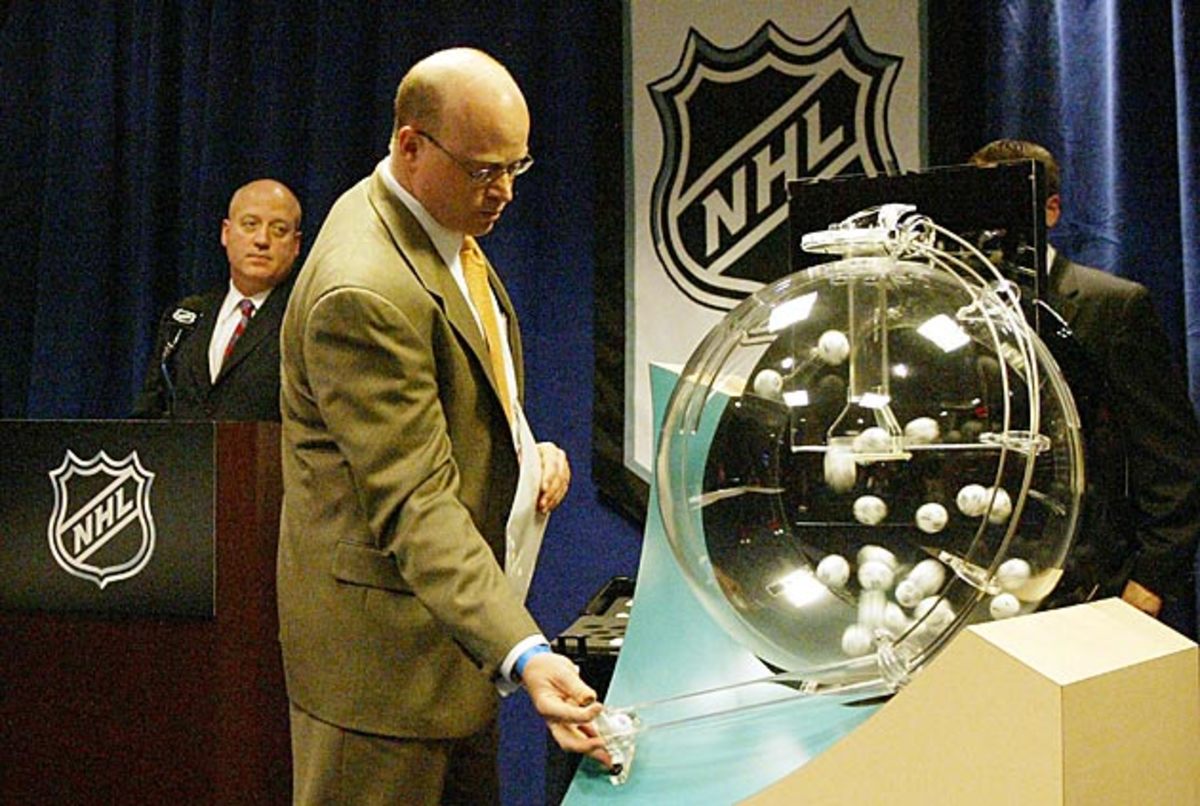
As a means to balance each team’s picks, the NHL instituted a “Snake draft” for the seven rounds: a team’s choice from the top of the draft order in one round would then follow with a pick from the bottom of the draft order in the following round. The Penguins, for example, chose Crosby with the first selection in the first round and then chose Michael Gergen with the last pick in the second round. This was a rarity in modern drafts.
Meagher: “As I recall it was a brilliant plan. No one was happy but at the end of the day, there was no pushback. But there was unanimous support for this process. You couldn’t make everyone happy but it’s like anything else. You come up with a plan that made the most sense. It had a fairness to it.”
Burke: “That part made sense to me.”
The much-anticipated draft lottery to determine who would have the right to choose Crosby was held on July 22, 2005 at the Sheraton New York Hotel and Towers, just after the CBA was ratified.
Meagher: “The draft lottery was more of a challenge than the actual draft. We actually had two different rooms. We had the lottery machine with each of the representatives from the 30 different teams in one room and we had this TV set with a rep from each team for the public unveil in another room.”
Burke: “I thought we were going to win. Don’t ask me why. We had a 50/50 chance but I had an overpowering feeling that we were going to get him. When I went up to the stage to do the draw and James Duthie said ‘And we’ll be right back.’ They went to commercial and I said to him ‘I’d kill you right now if I could get away with it.’ I thought we were going to win and there’s no rational basis for that.”
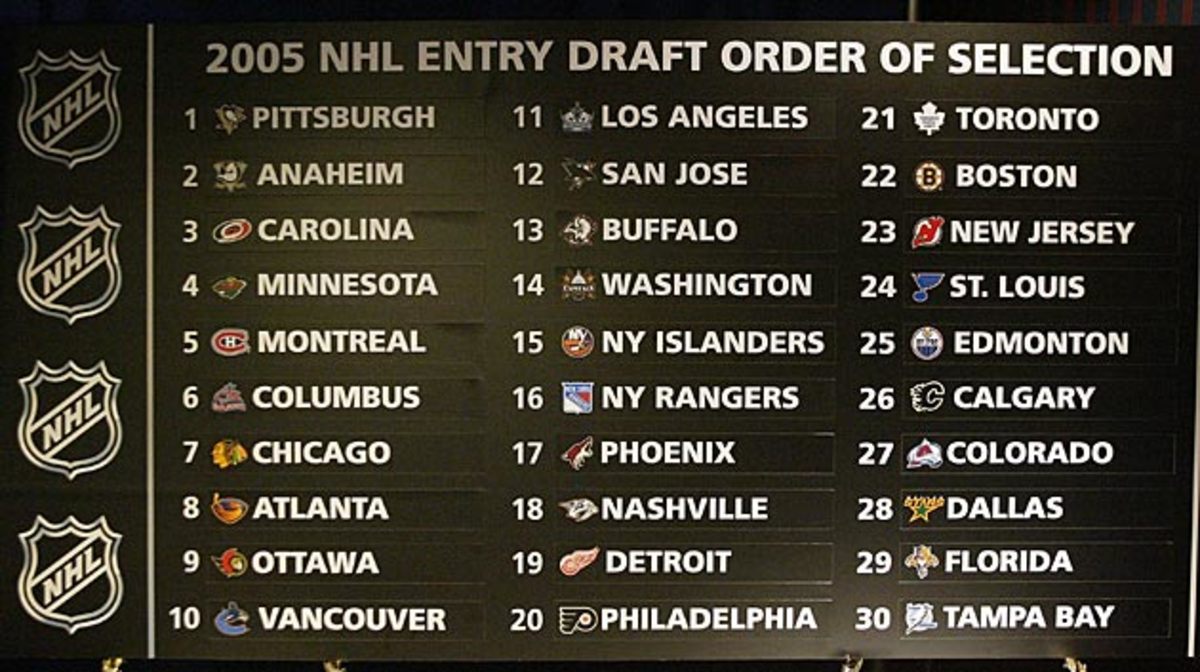
Planning the draft
The NHL soon got to work planning and arranging the 2005 Entry Draft. Because of the logistical challenges of putting it together so quickly, it became obvious that the draft could not be held at the Corel Centre in Ottawa, as was originally scheduled. Even though the arena was available, the NHL decided to scale down the event and host it at the Westin Hotel instead. But holding one of the most anticipated drafts in league history in a ballroom presented a new, interesting set of challenges for the NHL and its organizers.
Meagher: “We realized that having a traditional draft in Ottawa would’ve been impossible to pull off.”
John Jarvis, then-GM of the Westin: “We booked this piece of business about two weeks out. We were on cloud nine. Not only would we have a full hotel but we’d have all the media in North America there. It was prime time.”
Meagher: “The day before the draft we took the prospects up to Parliament Hill. So even though it wasn’t really a public draft we wanted to make it seem like one. We tried to bring that component to the draft, recognizing that we couldn’t have the public there. It was more of a business-like environment at the draft. It was a challenge but it accomplished everything it needed to do.”
Jarvis: “When they first announced they were going to do it, we thought ‘Are they going to use the Convention Centre next door?’ And they then announced that they would hold it at our hotel and they said they wanted it quick and simple. You have to remember that you need 30 suites, one for each of the teams. Each team would have a command center. And each suite might need additional meeting rooms and the bedrooms they needed as well.”
Meagher: “There was so much to accomplish. Yes, you would’ve liked to have had a traditional draft. But the draft was just the first step in a whole bunch of critical dates of player signings, putting team rosters together, etc. We were just six weeks away from training camp. With the new rules under the CBA and the need for teams to put players on the roster, it was more than just excitement.”
Jarvis: “We then needed to create absolute security on our convention level where they could move their whole group into the ballroom. You didn’t want to have Joe Public wandering through because we just didn’t have the space. There were hundreds and hundreds of people waiting outside the hotel to try and get autographs. It was an absolute media circus. The lockout had just ended so everyone wanted to see what was happening.”
Meagher: “From a team and league standpoint the focus was just to get hockey back up and running. Recognizing what was at stake, with Sidney Crosby being drafted and that, you had to still do the right things from a visibility and promotional standpoint in terms of the draft and the lottery.”
Jarvis: “Some teams were upset that they didn’t get a big enough suite. That wasn’t for us to determine. That was up to the NHL. We didn’t say, ‘We like Los Angeles but we don’t like Toronto.’”
The most glaring fallout of having the draft at a hotel as opposed to an arena, as had become custom, was the fact that many top prospects and sure-fire first round picks would not attend. Instead, the NHL invited only the Top 20 ranked prospects. While many players were excited to be invited, some missed out on the chance of a lifetime. And, as was to be expected with this draft, it all came together quickly.
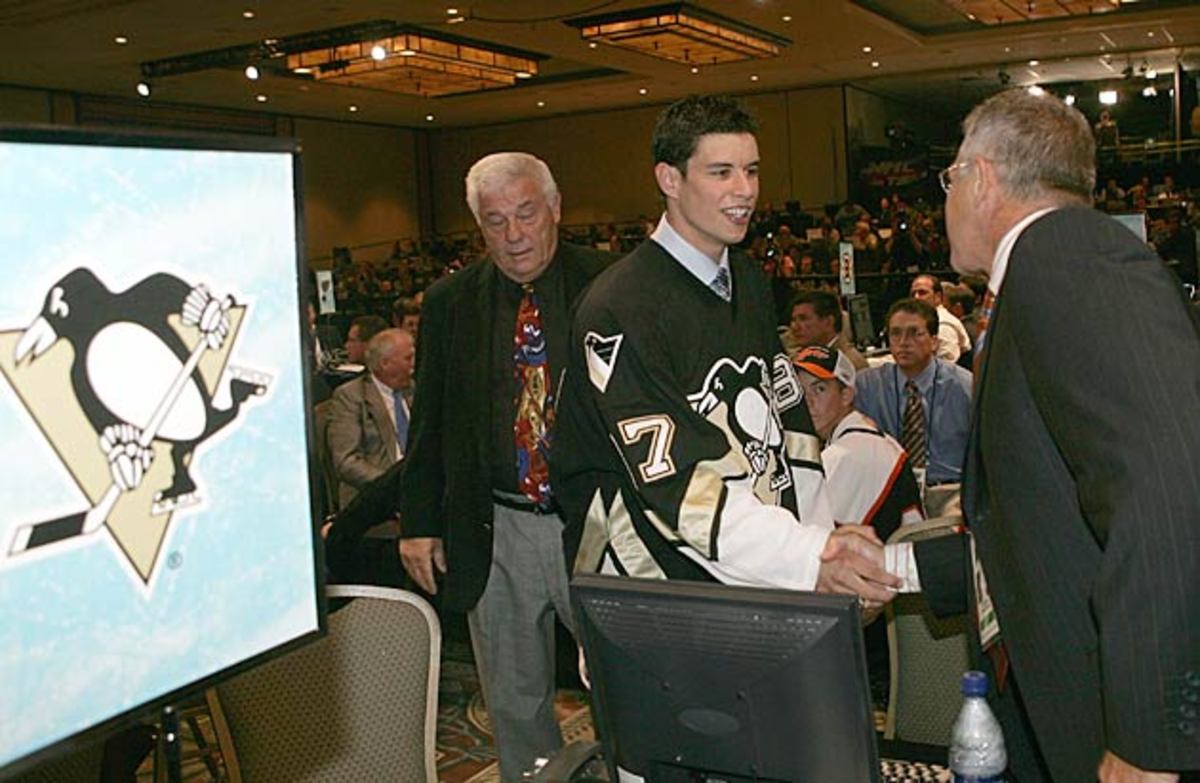
•Eastern teams all-time worst picks | Western teams
Brian Lee, defenseman, drafted ninth by the Ottawa Senators: “I was invited only two weeks before. I was pretty surprised.”
Ryan O’Marra, center, drafted 15th by the New York Islanders: “My agent, Larry Kelly, had given me a heads up that the Top 20 ranked prospects would be getting invited. I think I’d known for quite some time because the final rankings came out early and I’d been fortunate enough to be rated high enough. I don’t want to say I’d known for months but it wasn’t as if I found out a week or two before.”
Gilbert Brule, drafted 6th overall by the Columbus Blue Jackets: “Throughout the year they do the rankings for the prospects so you have a rough idea about whose going to go first, obviously it was Sidney, but then there’s a bunch of guys that are close behind.”
Carey Price, goaltender, drafted fifth by the Montreal Canadiens: “Obviously it was a lockout year so we were all wondering what was going to happen. It seems like so long ago now. When we found out it was going to be in Ottawa we learned pretty late that it would be a pretty small set-up. No one was sure who was going or if it was just going to be a TV broadcast. My agent let me know that we’d be going and there was only 20 or 25 guys that’d be going.”
Marc Staal, defenseman, drafted 12th by the Rangers: “I wasn’t disappointed but a lot of us were confused going into the summer without knowing when or where the draft would be. The not knowing was tough. But once you got there it was a small group and it was pretty special to just be part of those guys that where there. It felt pretty exclusive.”
Lee: “To be honest, I’d never even watched a traditional draft on TV before. So it wasn’t all that different for me. Only afterwards did I watch other drafts on TV and I realized, ‘Oh, wow, that’s what they usually look like.’”
Jack Johnson, defenseman, drafted third by the Hurricanes: “It might have been cool to get the full experience but at the end of the day it's an opportunity to get in the NHL and that's what I got so I can't really complain."
Staal: “It was kind of hard to know what to expect. I’d grown up watching the draft on TV and seeing it in the arenas and on the big screen. It was a much more secluded event and had a much different feel to it. But there was still the same levels of nervousness and excitement as a normal draft.”
Anze Kopitar, center, drafted 11th by the Los Angeles Kings: “I stayed back in Sweden. My season had already began. The leagues in Europe start earlier and because of the lockout the draft was pushed back. So I didn’t have time to go. At that time I figured I’d just stay back and save myself the jetlag. But I deeply regret that right now. It’s a once-in-a-lifetime experience.”
Matt Pelech, right wing, drafted 26th overall by the Calgary Flames: “I expected to get drafted but I didn’t expect to get drafted as high as I did. We had some friends and family over to my parent’s house and we were watching in the basement. It was a big surprise.”
Staal: “My parents and my agent were with me and we were crowded around a table with another player, Devin Setoguchi. It was kind of an awkward situation to be in.”
[pagebreak]
Draft day differences
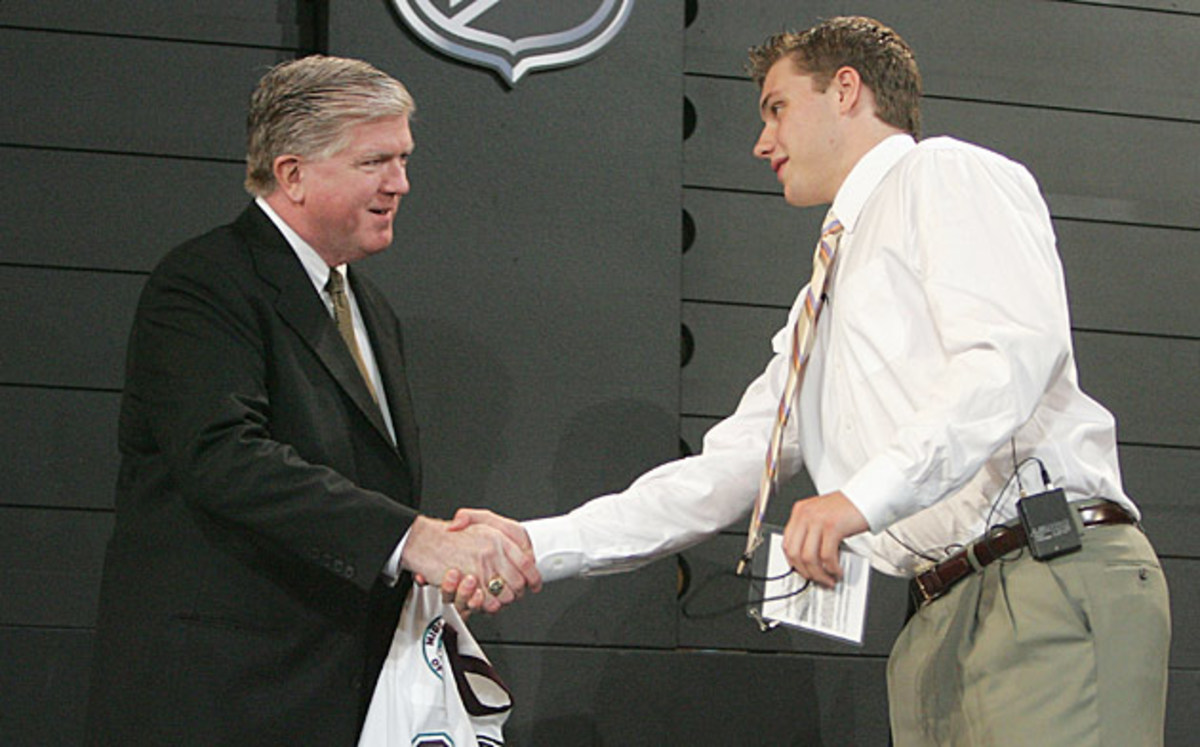
Hosting the draft in a hotel meant that teams had to adjust their strategies. What worked in the past, in terms of the way they interacted with each other on draft day, didn’t necessarily work in 2005.
Rutherford: “It’s easier to interact the way we do it normally. It definitely affected the way we did it.”
Burke: “We were pretty sure that no one had Bobby Ryan (photo above) as high as we did so we tried to trade down. We thought we could trade down and still get him. It was good in that way that everyone was close by. Some drafts are like that and sometimes there’s distance. You find a way to deal with the distance if there is distance. But the proximity was helpful.”
Jarvis: “I remember the NHL talking about the way it would be set up. They just told me, ‘Here’s the way it’s going to be.’ Coming out of the lockout there was so much cooperation. They were all radioing back to their suites. They only allowed six people per table. We didn’t have enough suites to accommodate everyone so every team was on a different floor. So they all had secondary command posts. Everyone was wired in there. The teams had a lot of their scouts in those rooms radioing back and forth. We couldn’t accommodate everyone together on the floor.”
Burke: “We were cheek to cheek at that draft.”
Rutherford: “It wasn’t difficult to actually draft players but it became more difficult to make deals or move up or down the draft or make a deal for a players. Clearly the way we do it now makes it easier to interact.”
Burke: “We tried to trade down with no luck. The teams picking behind us, Carolina, Minnesota, they weren’t interested. The last time I did that was with the Sedins and I was getting garlic and silver crosses tossed at me.”
SI Vault: Teen phenom Wayne Gretzky plays with maturity beyond his years
For many top prospects, getting drafted and walking up to the stage in front of a packed arena is their first taste of life in the big leagues. While the 2005 draft didn’t offer that experience, different players dealt with that change in different ways.
Price: “It didn’t bother me at all. I didn’t have any previous experience at the draft so I didn’t have anything to compare it to. I was just excited to get the opportunity to be drafted into the NHL.”
O’Marra: “I’d been in Carolina the year before. I’d flown down to meet some people and get a sense of the draft. So I saw it from the big arena standpoint. A major difference was that I went 15th overall and most of the guys are in the room with their parents. Four or five people per table, and by the point I was picked, everyone was already gone. There were only a handful of tables left. It was pretty nerve-wracking.”
Pelech: “I spent that day, which was an important day for me, with the people that are important to me.”
Brule: “Me and Carey Price played for the Quesnel Millionaires together when we were 15 years old. It was pretty cool to have one of your buddies in the room with you when you’re drafted into the NHL. It’s a pretty rare experience.”
Kopitar: “I watched it online with a few of my teammates. A few of them got drafted that year as well. Nicklas Bergfors and Tom Wandell were also drafted and were there too. We were anticipating it together. I was in Sweden and my family was in Slovenia. The team threw a bit of a party. It was like a formal dinner with everyone watching it. It was cool to have everyone around.”
Brule: “It would’ve been great if it were in an arena with all the fans and to have that kind of support and excitement behind you. But it was still very exciting to be in a room with five or six of the top guys in the draft. You look around the room and you see all the talent. It was quite amazing. I felt very lucky to be in that room.”
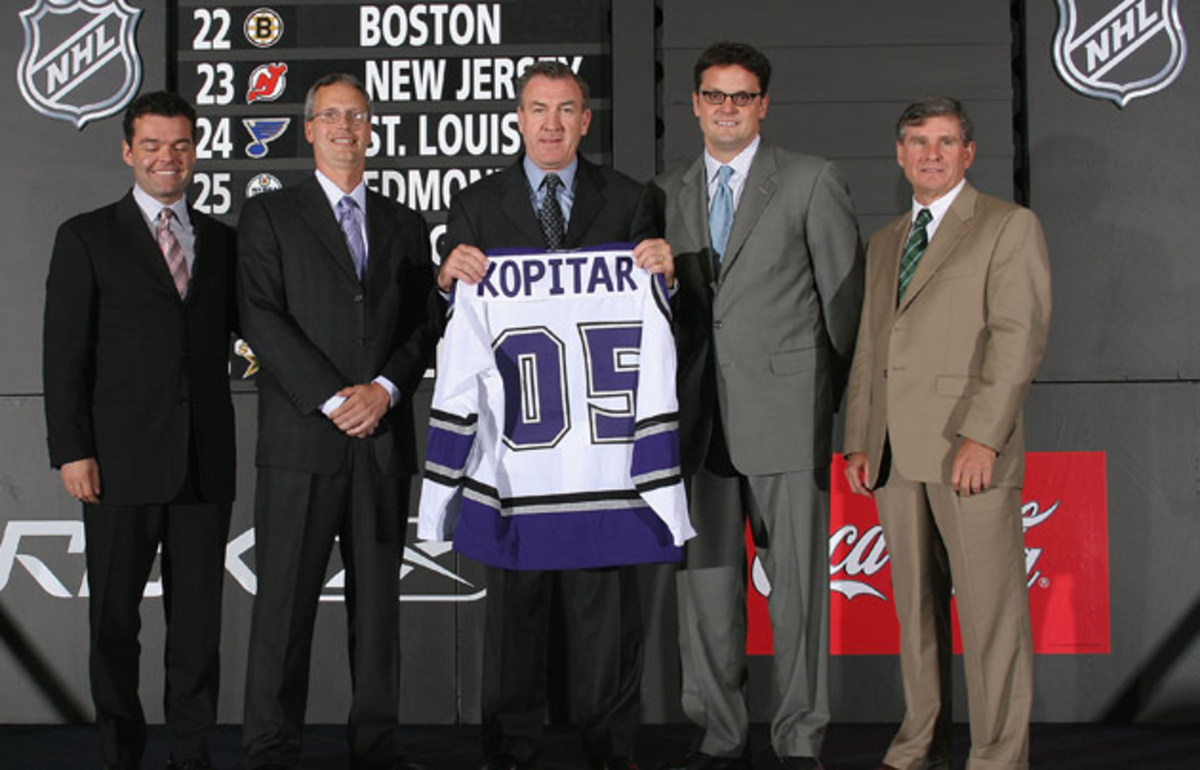
O’Marra: “I like the fact that in hindsight it was quite intimate. It was an intimate experience instead of being in the fray. I wasn’t (disappointed) at all. I was lucky to be there and I felt bad for the players that couldn’t attend.”
Brule: “In a small way I was disappointed. At the same time it was still an NHL Draft and it wasn’t holding us back from achieving our goals.”
Kopitar: “I would’ve gone if it had been earlier. A lot guys didn’t go, I think, because it wasn’t as big as it normally was.”
Sweet emotion
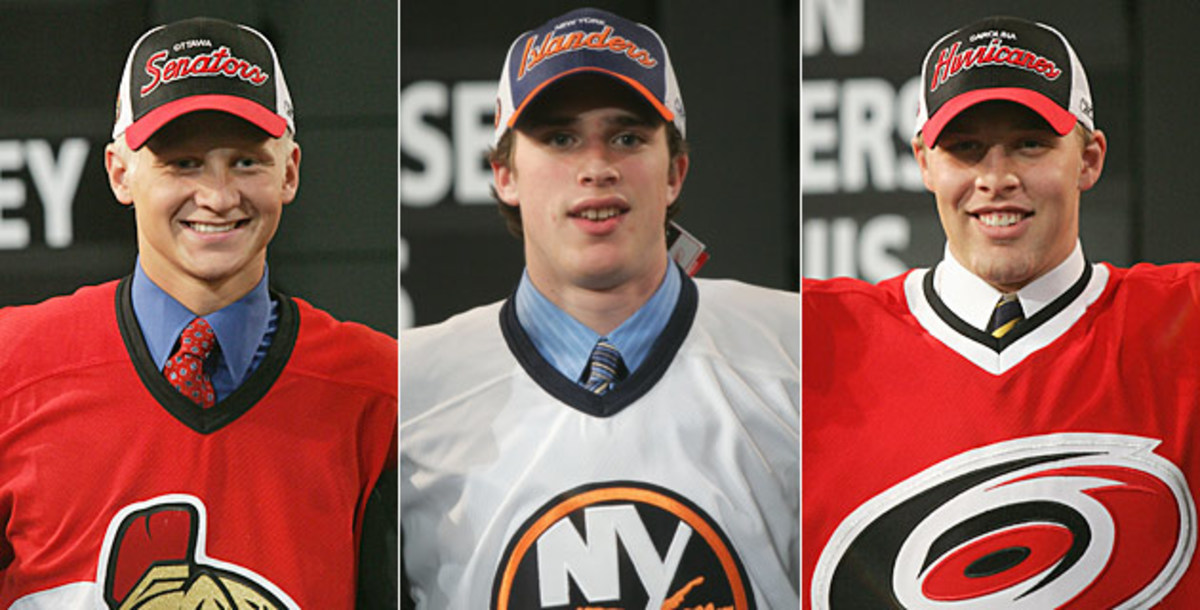
As with every draft, emotions ran high on draft day. First round picks look back on the day fondly, and even offer some advice to players who are going in this year’s draft.
Johnson: "I was nervous but mostly because I was hoping wherever I ended up was a great fit for me and my personality."
O’Marra: “The camera comes in close to you before the pick is announced. The cameraman knows who is being picked so you can imagine as the camera comes in towards you and your table and it doesn’t take a sharp right, you can imagine the thoughts and emotions that go through an 18-year old’s head. When I saw the camera coming I knew it’d be either myself or Ryan (Parent). It was sheer joy. [The Islanders are] a historical franchise. Their draft record is quite prominent. It was an honor, one of the highest thrills of my life.”
Staal: “No one knew where anyone would get picked. I had 29 interviews. I was projected to go middle of the pack. And there were a lot of players like that. I had absolutely no idea where I would end up, what team, what spot. I went in with my mind open and just waiting for my name to be called.”
Kopitar, on being the highest picked Slovenian player ever: “Obviously it was great because at that time you don’t really realize what kind of responsibility comes with that. I always wanted to be a good player but I had a lot more to deal with after that. A lot of eyes were on me. Suddenly I became the face for hockey in Slovenia and all the kids are looking up to you so you want to make sure you do it right. So far I think I’ve been on the right path.”
Lee: “You have to just relax and enjoy the day and be proud of your accomplishments. It’s a long road between being drafted and playing in the NHL so you have to celebrate what you’ve done.”
Price: “I was just going with it and taking in the experience. The first thing I thought when Montreal picked me was that I’d finally made it, so to speak. I didn’t really ‘make it’ but it was another step in the direction I was headed.”
Kenndal McArdle, drafted 20th by the Florida Panthers: “You’re already as nervous as you can be. I think that intimate setting probably took down the nerves if anything.”
O’Marra: “Take a lot of pictures and try to enjoy it because it goes by in a flash. And the next thing you know you might be wearing a suit every day to work.”
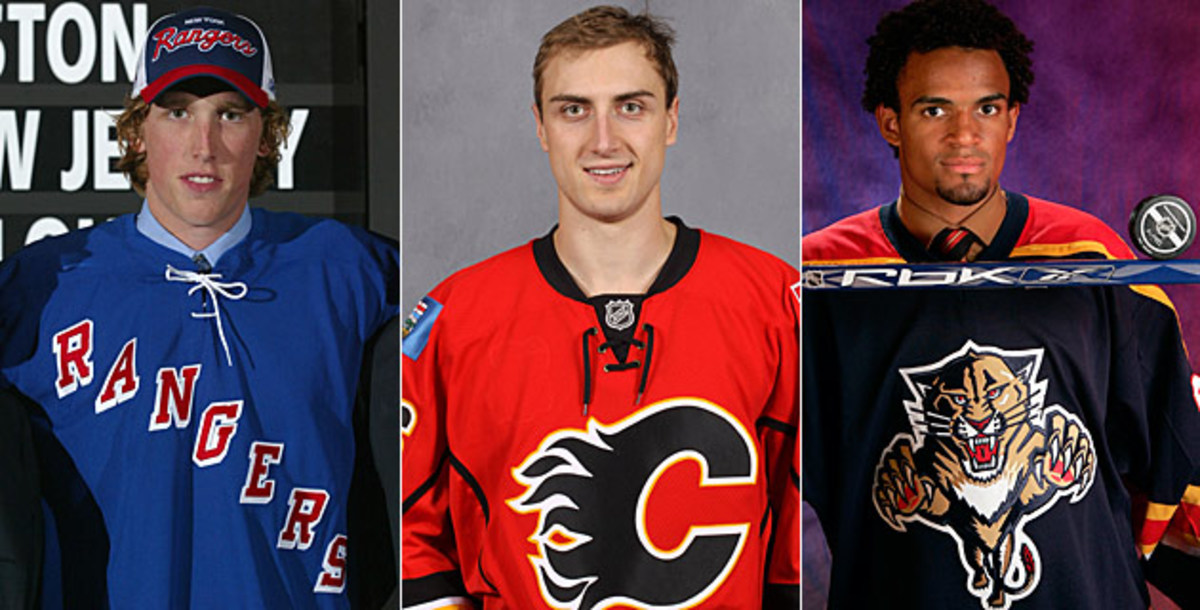
Day of surprises
Much like this year’s draft, the player who was going to be chosen first was a lock. But that doesn’t mean there weren’t surprises afterwards. Some entered the draft with a strong inclination of where they were headed while others did their best to avoid guessing of any kind.
Lee: “I thought I was going to get drafted by the Rangers. I even wore a red and blue tie for the occasion. But obviously things usually work out differently than you think they would.”
Brule: “Some people thought I might go to Montreal because I’m part French.”
O’Marra: “My career didn’t end up quite the way I’d hoped but going into the draft I was ranked a little higher than 15th. But New York wasn’t a team that I thought for sure was going to take me. But I learned afterwards that they were pretty dialed in on me. I’d done some psychology tests for them and they were happy. But I didn’t think I was going to any team specifically.”
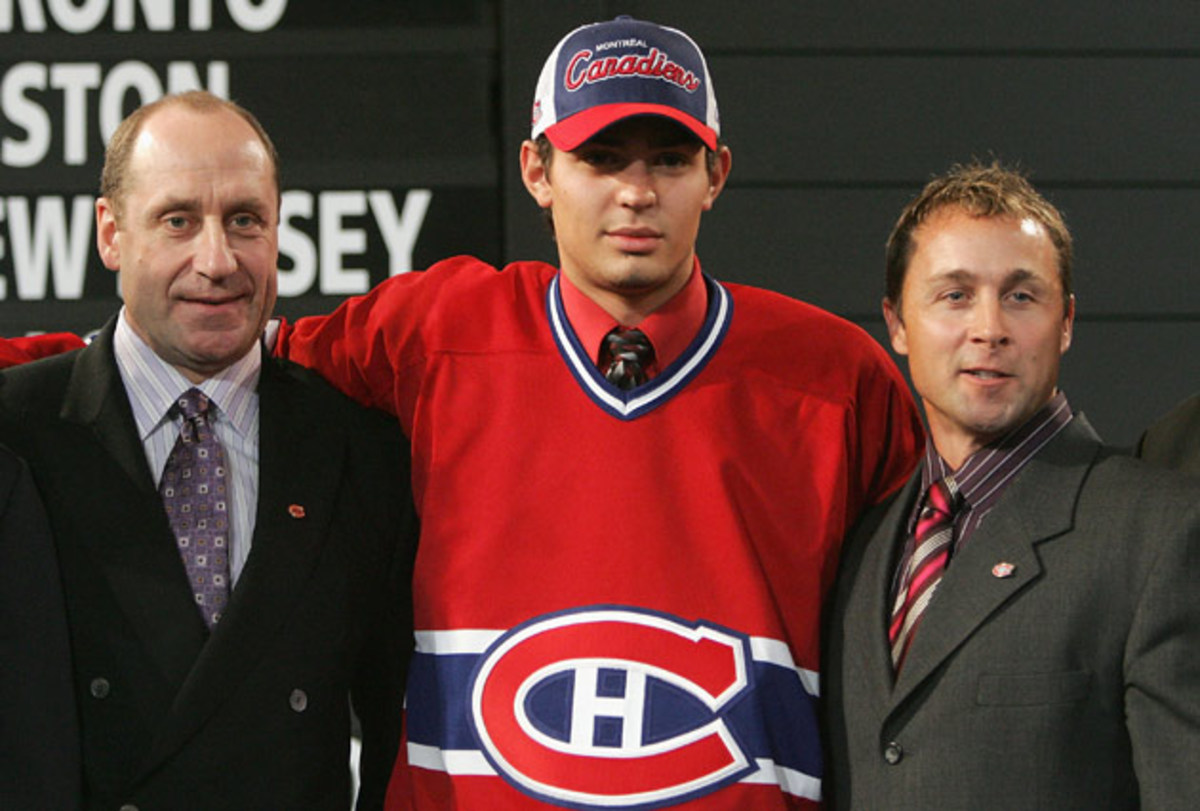
Price: “I had talked to several teams at the NHL combine. I wasn’t really sure who I’d be going to. I had a feeling that I might be going to Columbus, which was the next pick. I’d talked to Minnesota and Atlanta quite a bit so those were the teams that were going through my head quite a bit.”
Kopitar: “I thought at that point, I had a somewhat strong feeling or somewhat of an idea that I was going to Columbus. I had met with their GM a few times. All those meetings were very productive so I figured that was it. They were pretty straight forward by saying that if I was still available that they would pick me. It didn’t happen but at the same time I’m very thankful because being in L.A. we’ve had some success and it’s been great for me.”
Brule: “I talked to (Then Columbus General Manager Doug MacLean) and his son was actually in the room. His son was telling me that I was one of his favorite players. Doug liked the way I play hockey and was always very supportive of me.”
McArdle: “I had numerous conversations. I don’t recall who I thought was one of the most likely teams but it probably wasn’t Florida. They had traded down and had one of the last spots. That’s how drafts unfold. That’s why there is such a hype around it because you never know until it happens. There’s trades and this and that.”
O’Marra: “It’s fair to say nobody thought Gilbert Brule was going sixth.”
Johnson: "I had no idea, I had interviews with every team that year. I just sat and waited."
Rutherford on Johnson: “I wasn’t surprised he dropped to number three. The bigger surprise would’ve been if Sid dropped to number three.”
The aftermath
You hear it time and time again: the draft is a crapshoot. Players with incredible potential are vaulted into superstar status, such as Price and Kopitar. Often, however, injuries and other factors derail a prospect’s career.
• GALLERY: Notable NHL Draft Busts
A total of 15 of the 30 players who were chosen in the first round are still active on NHL rosters. Others are in the American Hockey League, some are plying their trade in Europe and others, such as McArdle and O’Marra, have hung up their skates for jobs in the financial industry.
McArdle: “Hockey is a lot different than the NFL. When you get drafted in the NFL, you’re hopping into the position you play right away. Hockey drafts kids at 18 years old. There’s still a lot of room for improvement and a lot of change that can occur in a player over time. That’s why it’s so hard to project. There’s such intangibles in hockey that it’s hard to guess how players are going to cope with the pro style.”
Brule: “It’s hard when you’re 18 years old coming into the NHL. I’d never been away from home and lived away from home for too long. I moved to Columbus when I was 18 and lived with one of my teammates. I didn’t have any of my family or friends. I was making new friends. It was difficult to go through that at such a young age.”
Burke: “It’s a rainbow spectrum. Some guys can’t make the commitment mentally, physically, can’t overcome injuries, don’t train enough. There’s not one answer.”
Lee: “I had too many injuries. I had three surgeries on my leg. I knew that if I tried to play again I might not be able to walk again. So I had to walk away from the game. That was tough, but it’s good to work with kids now at the hockey camp I run. Being around those kids makes me feel good about my time in the game.”
Burke: “Looking at this draft, it was probably on the stronger side. You want to see a bad first round, go back and look at the Sedins draft. There’s guys in there you’ve never even heard of. [Andrew] Cogliano, [Steve] Downie, [T.J.] Oshie, [Tuukka] Rask (2005 first round picks), they’re all still playing.”
Pelech: “I’d thought about Europe for a few years now since I’ve been bouncing around the minors for a little bit. We got a call a couple months ago with a team expressing interest. My wife and I sat down and thought it’d be a great opportunity.”
McArdle: “It probably happened a little quicker than I thought. But I it was something I wanted to do before it was all over. The last lockout year was a transition year. It was the first year when it was hard to find a job. My wife and I wanted to go to Sweden and experience a different kind of hockey. I had a lot of injuries and the North American game was taking its toll on me.”
SI Vault: Pittsburgh lands a rare bird in Mario Lemieux
Burke:
O’Marra: “The whole (summer of 2013) I waited on a job that didn’t materialize. I decided to push hard and finish my undergrad. I got better offers from Italy than I did anywhere else. The money my team (Fassa HC) was spending to win the championship was pretty good and I also thought it’d be a good opportunity to focus on school but still play hockey. The following year I went to play in England and complete my master’s degree as well. That was the plan I had for two years in advance. I had made amends with the fact I wasn’t going to play in the NHL forever.”
Burke: “Teams have bigger staffs and they’re paying more attention on a global landscape than before. It’s the best two days of the year for teams. Hope springs eternal. I think our draft is cooler than any other sport’s draft.”
